The BLM Continues Lack of Transparency in Adobe Town Wild Mare Radio Collar Study
February 13, 2017Wild Adobe Town Mares with Radio Collars Released in BLM and University of Wyoming Study
March 6, 2017BLM and University of Wyoming Continue Dangerous Radio Collar Study on Wild Mares
On Sunday I headed to Rock Springs, as I was told I would have an opportunity to view the release of the next group of wild mares back into Adobe Town with radio collars on their necks. If you have not been following my blogs on this you may be wondering incredulously “why would anyone do anything so cruel and dangerous to wild mares?”
Well read on and you will see.
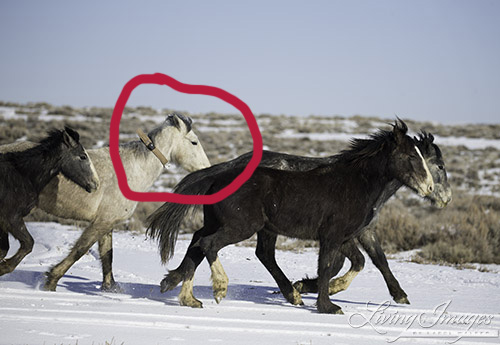
Notice the collar is not behind the ears, but much further down
Last week, the last mare to be released, Dove, who ran off with her family, had a radio collar that had slipped way down her neck, into what is NOT the correct position for the collar. Many people have been commenting on this, and I am still waiting for an explanation from USGS and the BLM about this. Here are the guidelines for the radio collars:
“The collar should rest just behind the ears of the equid and be tight enough so it does not slip down the neck, yet loose enough that it does not interfere with movement when the neck is flexed. The collar must fit snugly when the head is up to minimize rubbing. USGS researchers used 0-1 finger between collar and neck, depending on season collar is deployed to give consideration to the potential for weight gain. Other studies (e.g. Committee on Wild Horse and Burro Research 1991) have had problems with the fitting of collars due to animals gaining weight in spring, or losing weight in winter, causing collars to become too tight or too loose. In the USGS study, researchers did notice collars were looser or tighter at different times during the year, but it did not affect the behavior of collared mares or jennies, or cause sores or wounds on mares or jennies. Whenever collars are deployed they should be fitted by experienced personnel who can attach the collar quickly but proficiently to minimize handling stress on the animal.”
I am very concerned that this collar must be too loose, can slide around, and probably quite easily get caught in a hoof or a branch or a cliff or a fence. In my opinion, the University needs to immediately trigger the mechanism that they claim can remotely release the collar. I will keep you posted when and if I receive a response and explanation.
10 wild horses from Adobe Town are still at the Rock Springs facility. The longer they are there. the more likely they are to get diseases or become injured. They need to release these horses back into Adobe Town, where they were captured, immediately.
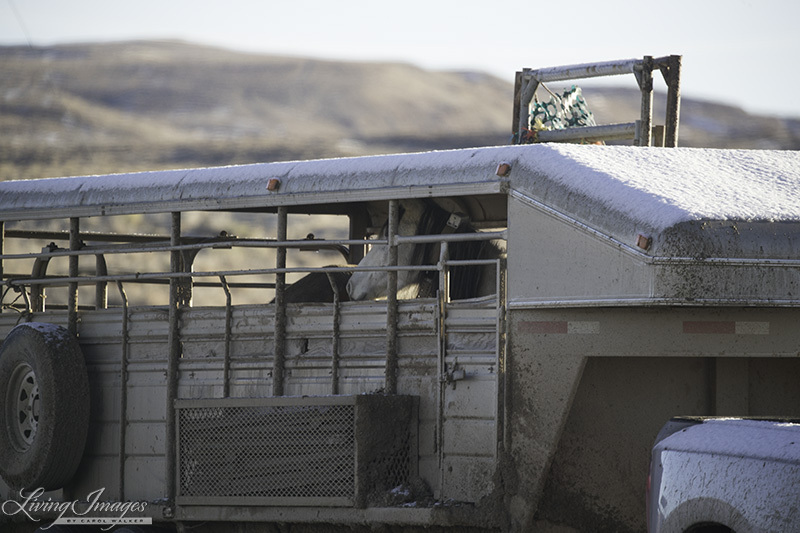
The first mare to be released
There were three mares in the trailer Monday morning as I followed the line of BLM and researchers out to the release sites. I was again the only member of the public along. We drove for over 2 1/2 hours before arriving at our first stop, which was in the northeast portion of Adobe Town, very near where the last mare, Dove had been released with her family.
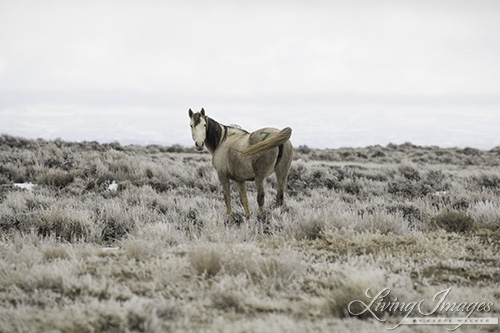
Dulcinea, looking calm
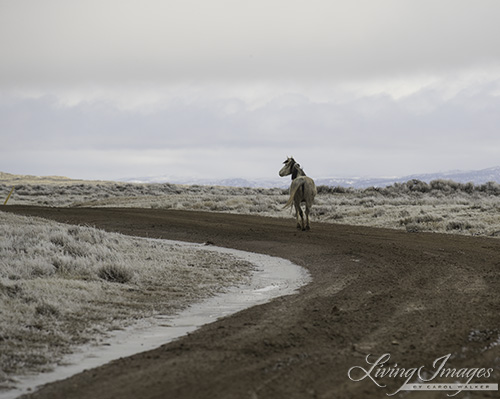
She trots down the road toward the incoming family band
This grey mare was older, and moved slowly out of the trailer, no panic for her, just curiosity as she looked back at us. I am calling her Dulcinea. She moved along familiarizing herself with where she was, for she had been trapped probably 15 miles from this area. Suddenly we see a family of wild horses moving along the hillside straight toward the road. She sees them, and lifts her head, then trots across the road toward them.
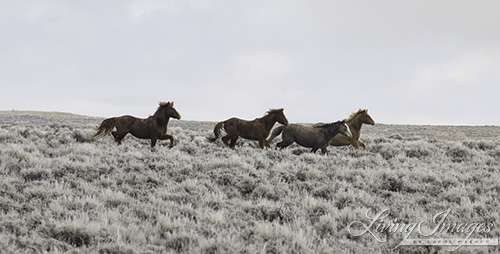
The family band running toward the mare, stallion in the rear
Clearly, she did not know them, but they went toward her then she ran in front of them.
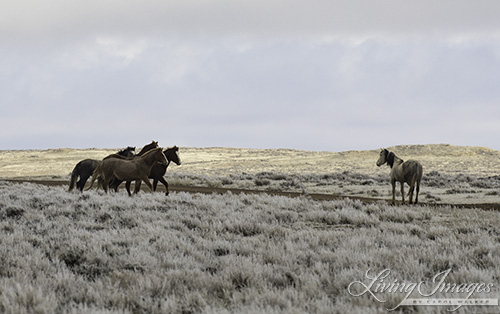
They approach Dulcinea
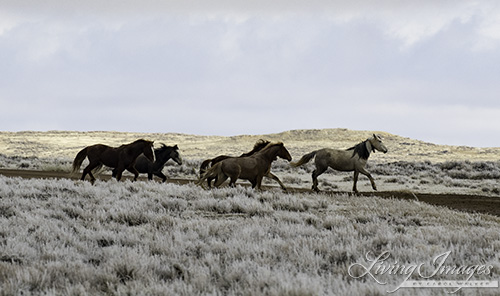
She runs in front of them
Then we see the stallion run up to her, sniffing her. She must smell quite strange, with all the odors of the holding facility and the trailer on her, plus the strange collar. But he seems to accept her and they run back to the family together.
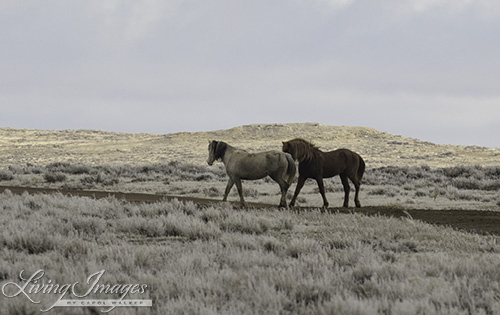
He sniffs her thoroughly
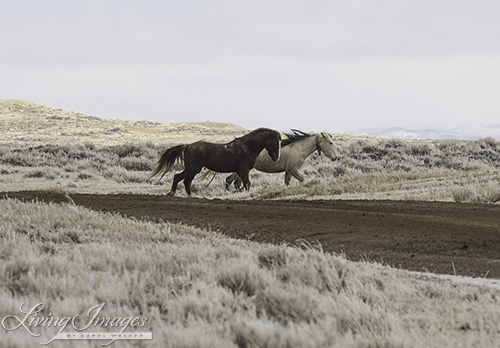
They run together
You might think that I would be happy about this. I was – it was far better than releasing her with no other horses in sight. But this was NOT her family, and that was made quite clear to me as we drove by them, and I saw her standing at quite a distance from this new family, as they interacted together. It was a very sad sight. Now she may become a very welcome member of this little family, but I think of what she has lost. Who knows how many years she was with the family she was captured with.
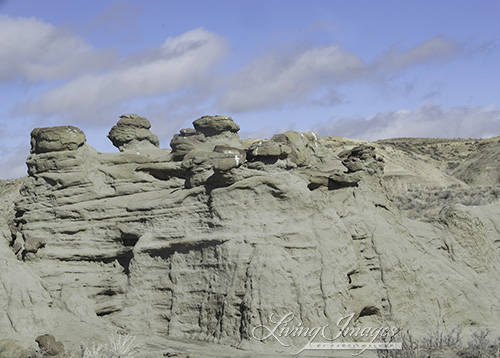
Rock formations in Adobe Town
We moved on down the road, and finally stopped again about 14 miles away by road – as the crow flies or the wild horse runs it could have been closer as the road twisted and turned. The landscape in the area was dramatic, as much of Adobe Town in, but no time to stop to admire the scenery – I shot this out the window.
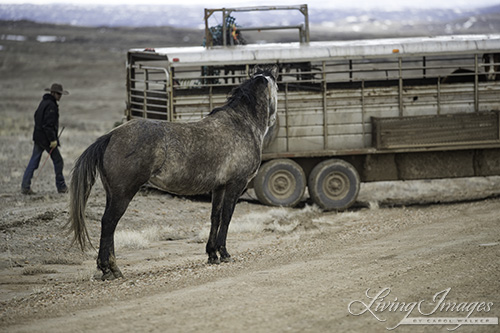
Rose looked back at the trailer
The second mare could not have been more different than Dulcinea. She came out of the trailer and looked back and whinnied at her friend who was still in the trailer. I do not know if they had been in the same family when they were captured, or just bonded in captivity, but she did not want to leave her. The contractor had to wave her away. And then she did not run off, but seemed unafraid and quite curious. Because she came so close I could see the sweat, some dried, some fresh, on her sides. Being in a moving trailer must be a terrifying thing to a wild horse, who was never gently and slowly introduced to it, as we do with our domestic horses.
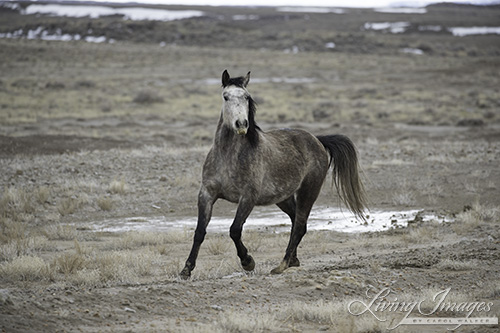
Rose moving toward us, unafraid
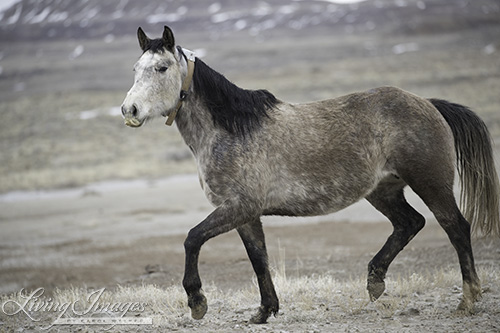
Rose trots by, quite close
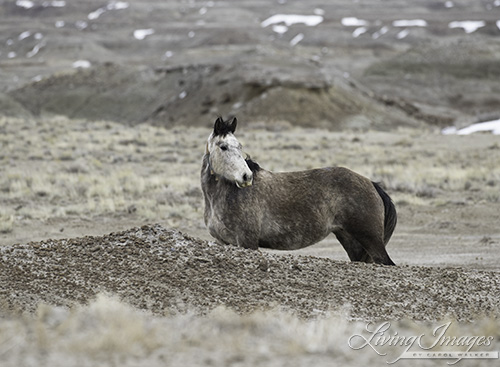
Rose looks back at her friend in the trailer
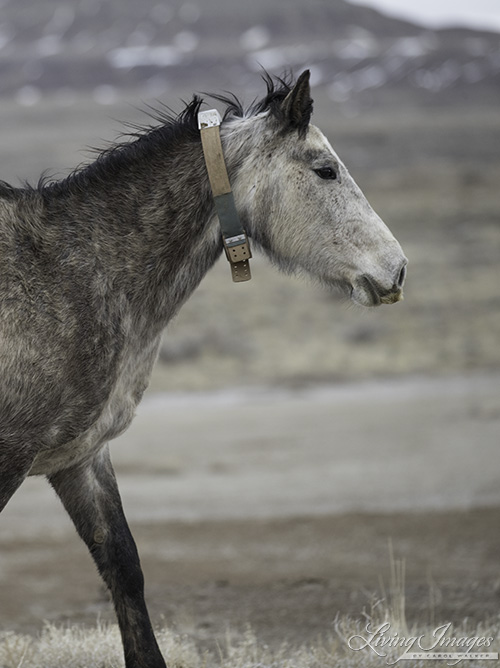
Close up of Rose’s collar which is more correctly positioned than Dove’s.
I am calling her Rose, as she is a young rose-grey mare. She had a small cut next to her eye, but it did not seem very big. As she moved away, we got back into our cars.
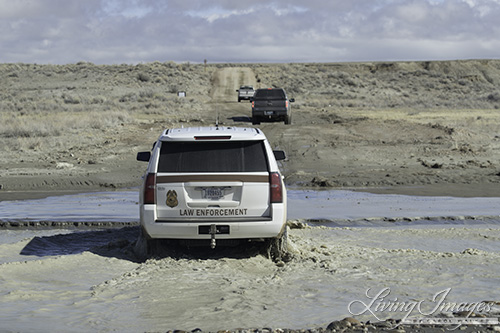
The road was challenging in spots
In this next stretch, there were some bad parts to the road, and it was all new to me – we were in a part of Adobe Town I had never traveled to before, 2 hours from the highway in two different directions. There was a huge and stunning ridge rising up, I think it is Skull Rim. We went about 15 miles from where we dropped off Rose.
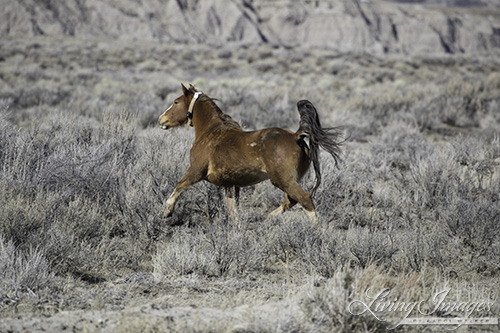
Scarlet moves out
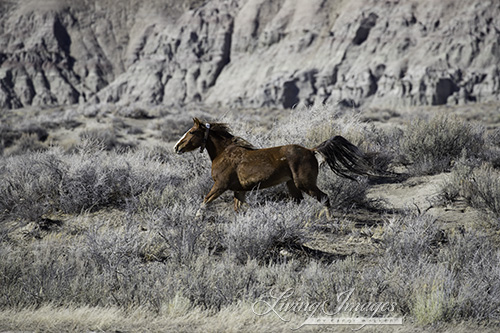
Scarlett in front of stunning rock formations
The last mare charged out of the trailer very assertively and moved at a stunning trot, tail flagged high. I am calling her Scarlett as she seems to have a fiery personality. There was no sign of other wild horses where we released her.
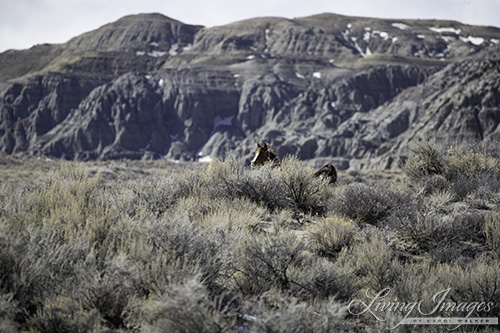
Scarlett looks back at us from the safety of a bush
We turned around and started the long journey back to a main road. As we were going, before we got to where we had released Rose, there was a wild horse family on the left side of the road, not far away. We stopped, and I was struck by the very strong familial resemblance. The four sorrels had almost exactly the same blaze, and I was struck by how this illustrates a very important aspect of wild horses who live wild and free.
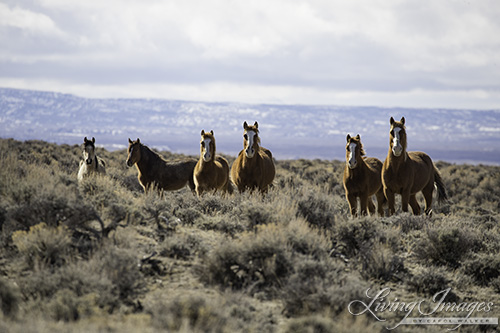
The family members on the right are so similar in markings and color
This family was very fortunate because it had not been broken up by a roundup or by the bait trapping of this study. The mare and her foal and foal and stallion looked so similar. Who knows how long this little family might have been together? Wild horses form close social bonds, and family members are not interchangeable, nor are they unimportant. This is where one of the greatest cruelties of this study lies, in the heedless breaking up of families, which cannot be undone. Of course, horses can travel great distances, but will they ever be a part of that family again? They have lost sisters, daughters, stallions, and the safety of that familiar and close family.
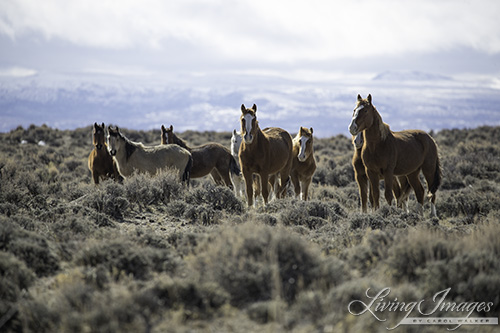
The whole family
This study by the University of Wyoming purports to study the movement of wild horses in Adobe Town. How much more relevant and accurate would their observations be if they had not yanked these mares away from their families and randomly set them down some many many miles from where they were captured? They are disturbing the horses, and risking the lives of these mares with this dangerous radio collar study. They can die from getting tangled up with these collars. Direct observation is much more humane and more relevant. I am hoping that all these mares survive the two years they have to endure wearing these collars, and that I will see them with other horses this summer.
Link to Daily Gather Reports:
Previous Posts:
The BLM Continues Lack of Transparency in Adobe Town Wild Mare Radio Collar Study
Stunning Lack of Tranparancy in BLM’s and University of Wyoming’s Adobe Town Wild Horse Study
Equine Advocates and Animal Welfare Groups Challenge Adobe Town Wild Mare Experimentation
Please Comment to Stop the Dangerous and Cruel Adobe Town Wild Mare Radio Collar Study

9 Comments
Hi Carol. Thank you for the report and for keeping eyes on these unfortunate mares. I am truly worried about Dove’s collar and hope that you do hear back from the BLM and they do trigger it to be released. I’m not holding my breath though as its apparent the BLM care very little for the welfare of these horses, or they wouldn’t do anything as dangerous as fitting them with these collars. I was wondering why the law enforcement vehicle was there? To keep away scary advocates who might want to see what is actually going on?
Thank you-
Angie
Excellent photo journaling, Carol.
This piece needs to be circulated around, printed up in newspapers, etc.
I’m heartbroken, frustrated and angry.
This study just does not make ant sense. Dropping them off separately and miles apart is cruel. That is not going to give them the accurate info on their movement!!!!
That collar hanging too low and tight on the neck of Dove is a tragic accident waiting to happen. They need to release it from her promptly. Something horrible better not happen in result of their negligence.
I have to say I adore the names you’ve chosen for these special girls.
Aren’t they all gorgeous! Truly, they have their very own personalities and so spirited and wild and smart. You can just tell.
I’m sorry that they are all confused as hell right now.
Thanks for the update. All we can do now is wait and hope and pray this goes well.
Thank you for watching what is happening and for keeping an eye on the horses. I just don’t understand why they were not released in better places for them (near to their family bands). It’s as if the university have no idea of horse ethology and if they have no idea, why on earth are they doing this crazy experiment?!
I love the names too. I hope that Dove’s collar does not end up causing a tragedy.
It is hard seeing the photos, because all I want to do is somehow make it alright for them. They are spirited and smart, and I hope that they at least are able to settle and not be totally confused by what has happened.
Thanks again, Carol, for the update. It still just amazes me that the BLM goes out of its way to put these horses into a strange environment! But then – no matter what university they have the grant with – it seems the only question they have is: Lets see what happens! With no empathy for the animals whose lives they have torn apart – just “research” subjects. It would be compassionate & just downright common sense to release the wrongly situated collar on the gray mare (Dove). And those are two attributes that dont seem to exist in these people.
Thanks for being there Carol documenting these horses. Please let us know what the response you get about Dove and her wrongly placed collar.
Hi Gayle,
Here is the response which addresses the collar flipping upside down but does not address that it has slipped 5-6 inches down below where it should be, behind the mare’s ears:
“The collars have been fitted to allow for weight gain. The mare in this photo the collar has spun around on her neck, which can happen during trailering back to the site, or if she lied down and rolled. The collars will spin a little, but they do right themselves due the weight of the battery pack eventually.
The collars have spun on the mares in Utah, but they all righted themselves eventually. Those mares have been collared and have been doing really well since August 2016. Also the burros have been wearing collars since April 2016, and they too have been observed upside down on their necks, but they have all righted themselves. This is common in other ungulates as well; that the collar can spin sometimes.
I do know that when they put this collar on this mare, they felt it fit her really well. There is padding on both ends, so the part that is in contact with her throat in the photo is padded as well. The concern is that her antenna is facing down, so ideally the collar functions better when the white part is facing the satellites. The collar is functioning on this mare and data is already being collected about her movements. If there is a collar becomes an issue for any mare it will be dropped off.
We appreciate you sending us the photo along with the inquiry.”
Thanks for this excellent report, Carol. I so agree with you on the dense and insensitive nature of this invasive study. Thanks for keeping a eye on this precarious situation!
Experimental subjects is all these horses are to the people doing these studies.
I don’t think these so called scientists have given enough thought to what they are doing to these mares–how they are affecting their lives. They are better off than being slaughtered but their lives are in danger. For people reading this, please post more comments.
Thank for bearing witness to this procedure.
I think the collars are too big and cumbetsome for a wild animal. I’m sure they will try to remove them and get hurt doing so.
Why not study them where they were with their families. Seems like a senseless and heartless study